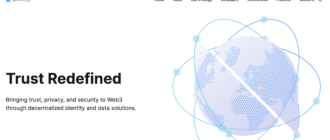This article delves into the eCash project and its associated cryptocurrency, XEC. We will explore various aspects of this project, including its history, technological infrastructure, tokenomics, ecosystem, growth prospects, and future outlook. Designed to serve as a decentralized electronic cash system, eCash aims to revolutionize digital transactions by combining the strengths of Bitcoin with innovative advancements in blockchain technology.

What is eCash?
eCash (XEC) is a cryptocurrency project designed to serve as a decentralized electronic cash system. It aims to combine the technological advancements of Bitcoin with innovative enhancements to deliver a scalable, secure, and fast digital payment solution. By leveraging the Avalanche consensus protocol, eCash ensures near-instant transaction confirmations and robust network security. The project focuses on creating a user-friendly and efficient cryptocurrency that can support high transaction volumes while maintaining low fees, making it suitable for everyday transactions and mass adoption.
History of the Project
eCash was launched in November 2020 as a rebranding of Bitcoin Cash ABC (BCHA), a fork from Bitcoin Cash (BCH). The project was initiated to address some of the scalability and usability issues faced by its predecessors. Key milestones in the development of eCash include:
- November 2020: eCash emerges from the split of Bitcoin Cash ABC.
- July 2021: The project rebrands from Bitcoin Cash ABC to eCash (XEC) to create a distinct identity and simplify its unit of account.
- 2021: Implementation of the Avalanche post-consensus protocol to enhance network security and transaction finality.
- Ongoing: Continuous development and integration of advanced features such as Schnorr Signatures for improved efficiency, adaptive block sizes for scalability, and CashFusion for enhanced privacy.
eCash’s roadmap includes ambitious goals to support massive transaction volumes and further integrate with decentralized finance (DeFi) ecosystems, positioning itself as a versatile and future-proof digital currency.
How Does eCash Work?
eCash (XEC) operates on a blockchain built to optimize for scalability, security, and speed. It incorporates several advanced technologies to achieve these goals, distinguishing itself from other cryptocurrencies through its innovative approach and unique features.
Blockchain and Consensus Mechanism
The eCash blockchain utilizes a combination of Proof of Work (PoW) and Proof of Stake (PoS) mechanisms, with an additional layer called Avalanche post-consensus. This hybrid approach leverages the strengths of both consensus mechanisms to enhance network security and transaction finality. Here are the key components:
- Proof of Work (PoW): Initially, eCash employs PoW to secure the network. This mechanism involves miners solving cryptographic puzzles to validate transactions and add new blocks to the blockchain, ensuring a high level of security and decentralization.
- Proof of Stake (PoS): To further increase efficiency and reduce environmental impact, eCash integrates PoS. In PoS, validators are chosen based on the number of coins they hold and are willing to “stake” as collateral. This transition helps in speeding up transactions and lowering energy consumption.
- Avalanche Post-Consensus: This innovative layer adds an additional security mechanism by ensuring rapid and irreversible transaction finality. Avalanche achieves consensus through repeated sub-sampled voting, which quickly propagates agreement across the network. This makes the network more robust against forks and double-spending attacks.
Technological Innovations
eCash incorporates several advanced technologies that enhance its performance and user experience:
- Canonical Transaction Ordering: This method allows for more efficient block processing by ordering transactions in a canonical sequence. It improves scalability by enabling faster and more efficient block validation.
- Schnorr Signatures: These signatures provide a way to batch multiple signatures into one, significantly reducing the size of transactions and increasing the network’s throughput. This is crucial for supporting a high volume of transactions per second.
- CashFusion Protocol: For privacy, eCash implements CashFusion, an advanced protocol that mixes transactions in a way that obfuscates their origin and destination, enhancing user anonymity without sacrificing efficiency.
- Adaptive Block Sizes: Unlike fixed block sizes, eCash employs adaptive block sizes that adjust based on network demand. This flexibility allows the blockchain to handle varying transaction volumes, supporting growth and reducing congestion.
- Subchains and EVM Compatibility: eCash supports the creation of subchains, which can be customized networks running parallel to the main chain. Additionally, its compatibility with the Ethereum Virtual Machine (EVM) allows developers to deploy smart contracts and decentralized applications (DApps) seamlessly, bridging the gap between eCash and the broader DeFi ecosystem.
Distinctive Features
eCash sets itself apart from other cryptocurrencies through several distinctive features:
- Low Fees: Transactions on the eCash network are designed to be nearly free, making it an attractive option for microtransactions and everyday use.
- Transaction Speed: With a goal to achieve transaction finality in under three seconds, eCash offers one of the fastest payment experiences in the cryptocurrency space.
- Economic Model: The re-denomination of its token to two decimal places simplifies transactions and enhances its appeal for mass adoption, contrasting with the more complex units used by other cryptocurrencies like Bitcoin.
eCash’s robust technological framework and strategic innovations position it as a pioneering digital currency aimed at mainstream adoption, offering a compelling blend of security, efficiency, and usability.
Tokenomics of eCash
eCash (XEC) is a cryptocurrency, more specifically a coin, as it operates on its own independent blockchain. This distinction is important because unlike tokens, which are built on existing blockchains like Ethereum, coins like eCash have their own native infrastructure.
Emission Model and Supply
eCash follows a similar emission model to Bitcoin, with a fixed maximum supply and periodic halving events. The total supply of eCash is capped at 21 trillion XEC. This large supply, when divided into smaller units, aims to make the currency more user-friendly and accessible for everyday transactions.
The emission of new XEC coins is governed by a halving schedule that reduces the block reward by 50% approximately every four years, or every 210,000 blocks. This mechanism is designed to mimic the scarcity and deflationary nature of Bitcoin, encouraging long-term value retention and investment.
Current Circulation and Market Dynamics
As of now, the majority of eCash’s supply is already in circulation. The developers have intentionally distributed around 90% of the total supply, holding back only a small portion for ongoing development and ecosystem support. This strategic distribution is aimed at minimizing inflationary pressures and ensuring stability in the coin’s value.
Price and Market Performance
eCash is actively traded on several major cryptocurrency exchanges, including Binance, Huobi, OKX, and others. The price of XEC, like many cryptocurrencies, is subject to market dynamics and can be highly volatile. Factors influencing its price include overall market trends, technological advancements, adoption rates, and macroeconomic conditions.
Unique Economic Features
eCash incorporates several unique economic features to enhance its functionality and appeal:
- Microtransaction Optimization: With its high supply and low unit price, eCash is optimized for microtransactions, making it suitable for daily use and small payments.
- Low Transaction Fees: The network is designed to keep transaction fees minimal, promoting its use as a practical payment method for a wide range of users.
- Incentives for Staking: Users can stake their XEC to earn rewards, contributing to the network’s security and stability. Staking offers a predictable and consistent return, making it an attractive option for those looking to earn passive income from their holdings.
Economic Model Comparison
Compared to other cryptocurrencies, eCash’s economic model is designed to encourage mass adoption by making the currency easy to use and understand. Its fixed supply and halving schedule align with the principles of digital scarcity, similar to Bitcoin, while its high supply and low unit price are intended to facilitate widespread usage and everyday transactions.
In summary, the tokenomics of eCash are structured to support both long-term value retention and practical usability, leveraging a robust economic model to drive adoption and integration within the broader cryptocurrency ecosystem.
Where to Buy eCash (XEC)
eCash (XEC) is available on several major cryptocurrency exchanges, allowing users to purchase and trade the coin with ease. Here is a list of prominent exchanges where you can buy eCash:
- Binance: One of the largest and most popular cryptocurrency exchanges globally, Binance offers a wide range of trading pairs and deep liquidity for XEC.
- HTX (Huobi): This exchange provides robust trading options and advanced security features, making it a reliable platform for purchasing eCash.
- MEXC: Known for its comprehensive selection of cryptocurrencies and user-friendly interface, MEXC is another good option for buying XEC.
- Bybit: Primarily recognized for its derivatives trading, Bybit also offers spot trading for eCash, catering to both experienced traders and beginners.
- KuCoin: KuCoin is celebrated for its diverse range of supported assets and competitive trading fees, making it a convenient choice for eCash transactions.
Where to Store eCash (XEC)
Storing your eCash securely is crucial to ensuring the safety of your assets. Here are some wallet options for storing XEC:
- eCash Official Wallet: The official wallet provided by the eCash project is optimized for XEC storage, offering robust security features and seamless transaction capabilities.
- Ledger Nano S/X: As hardware wallets, Ledger devices provide one of the highest levels of security by storing your private keys offline. They support a wide range of cryptocurrencies, including eCash.
- Trezor: Another reputable hardware wallet, Trezor offers excellent security features and ease of use, suitable for storing XEC securely.
- Atomic Wallet: A versatile software wallet that supports multiple cryptocurrencies, Atomic Wallet allows users to manage their XEC alongside other digital assets with ease.
- Trust Wallet: As a mobile wallet, Trust Wallet provides a user-friendly interface and strong security features, making it a convenient option for storing eCash on the go.
Storage Capabilities
Each of these wallets provides unique features tailored to different user needs. Hardware wallets like Ledger and Trezor are ideal for long-term storage and high security, keeping your private keys offline. Software wallets such as Atomic Wallet and Trust Wallet offer more flexibility and accessibility, suitable for users who need frequent access to their funds.
When choosing a wallet, consider factors such as security, ease of use, and compatibility with other cryptocurrencies you may own. Ensuring the safe storage of your eCash is vital to protecting your investment and ensuring quick access when needed.
Project Prospects
Growth Basis
The growth of eCash (XEC) is driven by its technological innovations and strategic focus on usability and scalability. The project aims to address key issues faced by earlier cryptocurrencies, such as slow transaction speeds, high fees, and limited scalability. By leveraging advanced technologies like Avalanche post-consensus, Schnorr Signatures, and adaptive block sizes, eCash enhances transaction speed, reduces costs, and scales efficiently to meet the demands of a growing user base.
Clients and Partners
eCash caters to a diverse range of clients including individual users, businesses, and developers seeking efficient and secure transaction solutions. Its low transaction fees and fast confirmation times make it attractive for everyday transactions and microtransactions. The integration with Ethereum Virtual Machine (EVM) also appeals to developers looking to deploy decentralized applications (DApps) and smart contracts.
Key Partners
- Binance: As a major exchange partner, Binance provides significant liquidity and trading volume for XEC.
- HTX (Huobi): Another key exchange partner, offering robust trading and security features for eCash users.
- Avalanche: The integration of Avalanche’s consensus protocol enhances eCash’s security and transaction efficiency.
- Various Developers and DApp Creators: Leveraging the EVM compatibility, many developers are building on the eCash platform, contributing to its ecosystem and driving innovation.
Development Forecast
The future of eCash looks promising due to its strong technical foundation and strategic partnerships. The roadmap includes further scalability enhancements, such as increasing transaction throughput to support mass adoption, and continuous improvements in privacy and security features. The project’s emphasis on user-friendly transaction units and integration with DeFi platforms positions it well for widespread adoption.
Ecosystem
The eCash ecosystem is expanding, driven by its advanced technological infrastructure and active community involvement. Key components of the ecosystem include:
- eTokens: Custom tokens that can be created and managed on the eCash blockchain, providing flexibility for various use cases.
- Staking Programs: Incentivizing users to stake their XEC, contributing to network security and earning rewards.
- CashFusion: An opt-in privacy feature that enhances transaction anonymity without compromising efficiency.
- Subchains: Customizable networks that run parallel to the main chain, allowing for specialized use cases such as zero-knowledge proofs and EVM-based smart contracts.
- Global Network Council (GNC): A governance body composed of stakeholders that oversees ecosystem funding and development, ensuring decentralized decision-making.
Additional Ecosystem Elements
- Developer Tools: Comprehensive tools and resources for developers to build and deploy applications on the eCash blockchain.
- User-Friendly Wallets: Multiple wallet options supporting XEC, enhancing user accessibility and security.
- Educational Resources: Initiatives to educate users and developers about the benefits and functionalities of the eCash platform.
The continued expansion of the eCash ecosystem, coupled with its technological advancements, positions it for significant growth and adoption in the cryptocurrency space.
Conclusion
eCash (XEC) represents a significant evolution in the realm of digital currencies, leveraging advanced blockchain technologies to offer secure, scalable, and fast transactions. As the project continues to develop and expand its ecosystem, it holds potential for substantial impact within the cryptocurrency landscape. This comprehensive exploration highlights the core components and ambitious goals of eCash, positioning it as a noteworthy player in the pursuit of a decentralized financial future.






